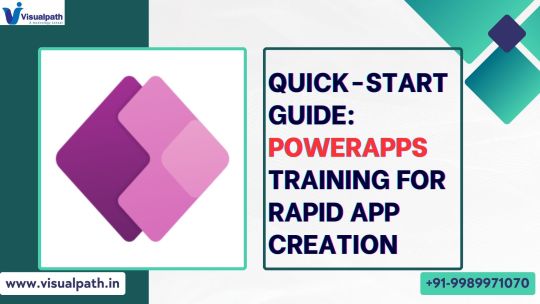#PowerApps and Power Automate Training
Explore tagged Tumblr posts
Text
PowerApps Training | Power Automate Training
Quick-Start Guide: PowerApps Training for Rapid App Creation

In today’s digital world, the ability to quickly create business applications tailored to unique needs is a highly sought-after skill. For individuals and businesses looking to harness this capability, PowerApps Training provides an accessible, effective path for developing low-code applications. This guide explores how PowerApps training empowers users to design and implement applications that streamline processes, boost productivity, and automate workflows. We’ll cover what makes Microsoft PowerApps Training essential for today’s business landscape, its integration with Power Automate Training, and how these tools work together to automate processes and solve real-world business challenges.
PowerApps, a component of the Microsoft Power Platform, is a low-code platform that allows users to create applications quickly and without extensive programming knowledge. This ease of use makes it a valuable tool for professionals looking to develop applications that meet specific business needs, from data entry forms to inventory management systems. With PowerApps Online Training, participants can learn to build apps at their own pace, understanding how to connect data sources, design user interfaces, and create functional applications. Paired with Power Automate Training, PowerApps enables users to create automated workflows that seamlessly integrate with other applications, such as Office 365, Dynamics 365, and SharePoint. Together, these two platforms create a powerful combination that enhances productivity and supports streamlined business operations.
What PowerApps Training Offers
PowerApps training covers the fundamentals of app design, data integration, and automation. A PowerApps Training Course walks learners through the essentials of app creation, such as data modeling, user interface design, and logic building. Trainees gain hands-on experience with PowerApps’ drag-and-drop functionality, which simplifies the process of building applications. PowerApps also allows users to connect to various data sources, including Microsoft Excel, Dynamics 365, and SQL databases. This data connectivity helps organizations manage and analyze information more efficiently, making it easier to generate actionable insights.
Through Microsoft PowerApps Training Courses, learners gain insights into Power Automate, which is closely linked with PowerApps and serves as the automation engine within the Power Platform. With Power Automate, users can create workflows that are triggered within PowerApps or across other applications. For example, a retail business could use Power Automate to create workflows that notify inventory managers of low stock levels or automatically generate invoices when a sale is recorded. PowerApps and Power Automate Training can transform how businesses manage repetitive tasks, saving time and minimizing errors.
For those seeking in-person training, PowerApps Training in Hyderabad provides an interactive experience that allows participants to work directly with instructors and peers. In these sessions, learners explore use cases relevant to their industry and practice creating applications that address specific business challenges. This hands-on approach ensures that participants are well-equipped to use PowerApps in real-world scenarios and supports the development of skills that can be directly applied to their work environments.
Benefits of Integrating Power Automate with PowerApps
One of the key advantages of Microsoft PowerApps Training is the integration with Power Automate, which enables the creation of automated workflows within applications. Power Automate Training focuses on building workflows that handle tasks such as data synchronization, notifications, and approval processes, all of which help streamline operations and improve accuracy. For instance, a company’s HR department could use Power Automate to develop a workflow that automatically generates on boarding documents and sends them to new hires after they accept a job offer. This automation can significantly reduce manual work, ensuring faster, more efficient operations.
Power Automate also connects PowerApps with numerous third-party applications, allowing for seamless integration across platforms. This cross-platform functionality is particularly valuable for businesses with complex technology stacks, as it eliminates the need for multiple, disconnected systems. Additionally, PowerApps Training Courses introduce users to the Power Platform’s security features, which ensure that applications and workflows adhere to organizational standards for data protection and access control. This aspect of training helps businesses maintain compliance with industry regulations while leveraging automation to its fullest potential.
Real-World Applications of PowerApps and Power Automate Training
Organizations across various industries have used Microsoft PowerApps Training to solve operational challenges through custom applications and automated workflows. For example, a healthcare organization could develop a PowerApps-based system for tracking patient records, allowing doctors and nurses to access and update information in real time. Using Power Automate, the organization could further automate notifications for patient test results or appointment reminders, improving service delivery and patient engagement.
For businesses involved in sales and customer service, PowerApps and Power Automate can streamline workflows by integrating with CRM systems like Dynamics 365. A PowerApps Training Course might teach users how to create applications that enable sales teams to track client interactions and automate follow-up actions, such as sending personalized emails to leads or generating reports on customer preferences. By combining these capabilities, businesses can enhance their customer relationship management processes, improve team collaboration, and make data-driven decisions that benefit their bottom line.
Conclusion
In conclusion, PowerApps Training and Power Automate Training provide the essential skills and knowledge needed to create efficient, automated business applications. Through PowerApps Online Training or in-person classes such as PowerApps Training in Hyderabad, individuals can gain the expertise to design applications that drive productivity, automate workflows, and support better decision-making. With PowerApps’ ease of use and Power Automate’s robust automation capabilities, businesses can address challenges, improve operational efficiency, and maintain a competitive edge. As the demand for low-code applications grows, the skills gained from Microsoft PowerApps Training Courses will continue to be valuable assets for any professional or organization looking to innovate and streamline processes in the digital age.
Visualpath is the Leading and Best Institute for learning in Hyderabad. We provide PowerApps and Power Automate Training. You will get the best course at an affordable cost.
Attend Free Demo
Call on – +91-9989971070
What’s App: https://www.whatsapp.com/catalog/919989971070/
Visit: https://visualpath.in/microsoft-powerapps-training.html
Visit our new course: https://www.visualpath.in/online-best-cyber-security-courses.html
#PowerApps Training#Power Automate Training#PowerApps Online Training#Microsoft PowerApps Training#PowerApps Training Course#PowerApps and Power Automate Training#PowerApps Training in Hyderabad#Microsoft PowerApps Training Courses
1 note
·
View note
Text
Power Apps Training in Ameerpet |Microsoft Power Apps Online Training
Enroll Now: https://meet.goto.com/472033469
Attend New Online Batch On Power Apps & Power Automate by Mr. Suresh.
Batch on: 16th May @ 8 PM (IST).
Contact Us: +91 9989971070.
Visit: https://www.visualpath.in/microsoft-powerapps-training.html

#visualpathedu#it#microsoftpowerapps#powerapps#powerautomation#powerappsonlinetraining#softwaretraining#newonlinebatch#powerappsbatch#Power Automate Training#Power Apps Training#Visualpath
0 notes
Text
Unlocking the Potential of PowerApps Office 365: A Comprehensive Guide
In today’s fast-paced digital world, organizations are increasingly turning to innovative tools like Microsoft Power Apps to streamline operations and enhance productivity. This pillar page provides an in-depth understanding of PowerApps Office 365, its integration, benefits, and how businesses can maximize its potential. Whether you're looking for insights on development, power apps consulting, or simply curious about the benefits of Microsoft Power Apps, this guide has you covered.
Table of Contents What is PowerApps Office 365? Key Features of Microsoft Power Apps Benefits of Microsoft Power Apps for Your Business PowerApps Integration with Office 365 Use Cases of PowerApps Power Apps Consulting: Why It’s Essential FAQs About PowerApps and Office365
What is PowerApps Office 365? PowerApps Office 365 refers to the seamless integration of PowerApps, a low-code application development platform, with Microsoft’s productivity suite, Office 365. This integration allows users to create customized business applications that leverage Office 365 data, enabling enhanced workflow automation and operational efficiency.
By connecting PowerApps with Office 365, organizations can:
Automate routine tasks. Create tailored solutions without extensive coding. Improve collaboration across teams.
Key Features of Microsoft Power Apps Microsoft Power Apps stands out with its user-friendly interface and powerful capabilities. Here are the top features:
Low-Code Development: Simplifies app creation, making it accessible for non-developers. Integration with Microsoft Ecosystem: Connects seamlessly with Office 365, SharePoint, Dynamics 365, and other tools. AI Integration: Offers prebuilt AI components to enhance application functionality. Data Connectivity: Accesses data from hundreds of sources using Microsoft Dataverse. Responsive Design: Ensures applications are optimized for mobile and desktop use.
Benefits of Microsoft Power Apps for Your Business Adopting Microsoft Power Apps can revolutionize how your business operates. Here are some key benefits:
Cost-Effectiveness: Reduce reliance on third-party software by building custom solutions in-house. Increased Productivity: Automate repetitive tasks, freeing up employee time for strategic initiatives. Enhanced Collaboration: Use data-driven insights from Office 365 for better decision-making. Scalability: Develop applications that grow with your business. Improved User Experience: Create intuitive apps tailored to your team’s specific needs.
PowerApps Integration with Office 365 One of the greatest strengths of PowerApps Office 365 lies in its integration capabilities. With Office365, users can:
Create apps that pull data directly from SharePoint, Excel, and Teams. Automate workflows using Power Automate, a companion tool. Design interactive dashboards that leverage Power BI insights. For instance, a sales team can use ms power apps to create a lead tracking app connected to Office 365 data, streamlining updates in real-time.
Use Cases of PowerApps PowerApps can address a wide range of business challenges. Here are some real-world applications:
Employee Onboarding: Automate HR workflows using apps integrated with SharePoint. Inventory Management: Track and manage inventory seamlessly with custom apps. Customer Service: Create solutions that pull data from Dynamics 365 to enhance customer interactions.
Power Apps Consulting: Why It’s Essential If you're new to Microsoft Power Apps, partnering with a power apps consulting firm can accelerate your journey. Expert consultants can:
Assess your business needs and recommend tailored solutions. Provide training for your team. Help with app design, development, and deployment.
FAQs About PowerApps and Office365 Q: Is PowerApps included with Office 365? A: Yes, most Office 365 plans include basic access to PowerApps, but advanced features may require a premium license.
Q: Can I integrate PowerApps with third-party tools? A: Absolutely. PowerApps supports integration with over 275 data connectors, including Salesforce, Google Drive, and SQL databases.
Q: What is the cost of Power Apps consulting? A: The cost varies based on project complexity and the consulting firm’s expertise. Generally, it’s an investment that pays off through increased efficiency and custom solutions.
Conclusion: Leveraging PowerApps Office 365 empowers businesses to innovate without extensive coding. Whether you're automating workflows, building custom applications, or improving data insights, Microsoft Power Apps is a game-changer. With professional power apps consulting, your business can unlock new levels of productivity and scalability.
0 notes
Text
Generative AI in IT Workspace: Trends and Innovations to Watch
Generative AI is rapidly transforming industries, and the IT workspace is no exception. From automating routine tasks to enhancing decision-making, Generative AI is reshaping how IT teams work, innovate, and optimize operations.

This article explores the latest trends and innovations in Generative AI in IT workspaces, helping IT leaders and professionals stay ahead of the curve.
The Rise of Generative AI in IT Workspaces
Generative AI refers to AI models capable of creating content, code, and insights based on training data. In the IT workspace, this technology is being leveraged for:
Automating Code Generation
Enhancing IT Support and Helpdesks
Optimizing Cloud and Infrastructure Management
Detecting and Responding to Cybersecurity Threats
Personalizing IT Solutions and User Experiences
With advancements in AI models such as GPT-4, Bard, and Llama, IT professionals are now integrating AI-driven solutions to improve workflows, boost efficiency, and reduce operational costs.
Key Trends in Generative AI for IT Workspaces
1. AI-Driven Code Generation and Software Development
Generative AI tools like GitHub Copilot, Tabnine, and Amazon CodeWhisperer assist developers by: ✅ Suggesting and completing code in real-time ✅ Debugging and optimizing existing code ✅ Generating scripts, automation workflows, and test cases
This significantly reduces development time and minimizes errors, allowing teams to focus on innovation rather than repetitive coding tasks.
2. Intelligent IT Support and Chatbots
AI-powered chatbots and virtual assistants are revolutionizing IT support desks. Tools like ServiceNow AI, IBM Watson, and Zendesk AI: ✅ Provide real-time troubleshooting solutions ✅ Automate ticket generation and resolution ✅ Offer predictive support based on user behavior
This results in faster response times, reduced IT workloads, and improved user experience in workplace IT environments.
3. AI-Augmented Cybersecurity
With increasing cyber threats, AI is being integrated into security operations. Generative AI assists in: ✅ Identifying anomalous behavior and security vulnerabilities ✅ Automating incident response and threat intelligence analysis ✅ Strengthening phishing detection and fraud prevention
Companies like CrowdStrike, Darktrace, and Microsoft Defender AI are pioneering AI-powered cybersecurity solutions to keep IT environments secure.
4. IT Infrastructure and Cloud Optimization
Generative AI is playing a vital role in cloud computing and IT infrastructure management by: ✅ Predicting system failures and automating maintenance ✅ Optimizing cloud resources and cost management ✅ Improving network performance and monitoring
AI-driven platforms like Google Cloud AI, AWS AI, and Microsoft Azure AI are enabling IT teams to build more efficient, self-healing systems.
5. AI-Powered IT Documentation and Knowledge Management
One of the biggest pain points in IT workspaces is maintaining up-to-date documentation. Generative AI automates: ✅ Creating IT manuals, SOPs, and troubleshooting guides ✅ Summarizing logs, reports, and system changes ✅ Generating FAQs and self-service content for users
This ensures IT teams always have accessible, well-structured documentation without spending hours manually updating records.
Innovations Driving Generative AI Adoption in IT
1. AI-Powered No-Code and Low-Code Development
With tools like Mendix, OutSystems, and Microsoft PowerApps, businesses are enabling citizen developers to build applications without extensive coding skills. Generative AI enhances these platforms by: ✅ Auto-generating UI designs and workflow logic ✅ Providing real-time code suggestions and debugging ✅ Enhancing API integrations and automation
2. AI-Augmented IT Decision-Making
Generative AI is helping IT leaders make data-driven decisions by: ✅ Analyzing massive datasets to extract valuable insights ✅ Predicting IT system failures before they occur ✅ Suggesting process optimizations based on historical trends
AI-powered analytics tools like DataRobot AI, H2O.ai, and Google Vertex AI are leading this innovation.
3. Personalized AI Workspaces for IT Teams
Future IT workspaces will be AI-driven, personalized, and highly automated. This includes: ✅ AI-assisted dashboards that adapt to user behavior ✅ Automated scheduling and workflow optimizations ✅ Personalized IT recommendations based on role and expertise
Tech giants like Microsoft and Google are already integrating AI copilots into workplace tools to enhance IT productivity.
Challenges and Considerations
While Generative AI in IT workspaces offers immense benefits, it also presents challenges: 🔴 Security Risks – AI-generated content could lead to vulnerabilities if not properly monitored. 🔴 Data Privacy Concerns – AI requires large datasets, raising concerns about data protection. 🔴 Ethical AI Usage – Bias in AI models can result in flawed decision-making. 🔴 Over-Reliance on AI – Human expertise is still crucial to validating AI-driven outputs.
To mitigate these risks, IT teams must adopt responsible AI frameworks and ensure continuous monitoring of AI-generated content.
Conclusion
The integration of Generative AI in IT workspaces is just beginning. In the coming years, we can expect: ✅ More advanced AI copilots for developers, IT admins, and cybersecurity professionals ✅ Deeper AI integration into ITSM (IT Service Management) platforms ✅ Stronger AI-driven automation in DevOps, cloud computing, and security
By staying informed about trends and innovations in Generative AI, IT leaders and professionals can leverage AI-driven tools to enhance efficiency, security, and innovation in their workspaces.
0 notes
Text

#Visualpath is Best institute in Hyderabad offers top #MicrosoftDynamics365 CRM with real-time expert instructors, highly skilled and certified trainers with 10+ years of experience. and hands-on projects. Microsoft #Dynamics365 training Courses, from industry experts and gain experience. We provide to individuals globally in the USA, UK, Canada, Dubai, and Australia, etc. To schedule a demo, call +91-9989971070.
Course Covered:
Microsoft Dynamics 365, Power Apps, Power Automate, Power BI, Azure Logic Apps, Microsoft SharePoint, Dynamics 365 Sales, Microsoft Flow, AI Builder
Whatsapp: https://www.whatsapp.com/catalog/919989971070
Visit our Blog: https://visualpathblogs.com/
Visit: https://www.visualpath.in/online-microsoft-dynamics-crm.html
#MicrosoftDynamicsCRM#DynamicsCRM#MicrosoftDynamics365#dynamics365crm#CRMSoftware#DynamicsCRMTraining#LearnDynamicsCRM#CRMImplementation#MicrosoftDynamicsCertification#PowerApps#powerplatform#businessintelligence#MSDynamics#D365#Dynamics365#Microsoft#dynamics#dynamics365crm#powerappscrm
#Microsoft Dynamics CRM#Microsoft Dynamics 365 CRM#Microsoft Dynamics 365 Training Courses#Microsoft Dynamics CRM Certification#dynamics crm online training#Dynamics 365 online training#Dynamics 365 crm training course#Dynamics crm training#MS Dynamics CRM Training in Hyderabad#Microsoft Dynamics CRM Online Training
0 notes
Text
Power Automate vs. Power Apps: Understanding Their Unique Roles in Business Automation
Automation and app development are the two significant areas that make business more efficient. Among the tools that facilitate this, Microsoft's PowerApps vs PowerAutomate are the two tools which help in this area. The user can create a custom app in a very short time with a PowerApps training course and less coding compared to the traditional method, and Power Automate automates repetitive tasks across applications.
As per reports recently 85% of businesses already use automation tools for optimizing workflows. Both do integrate with Microsoft services as well as third-party applications but have different purposes.
This article at Emergenteck explores the functionalities, differences, and ideal use cases of PowerApps vs PowerAutomate, making it possible for you to determine what is best applied to any situation to drive maximum value in your business operations between Power Automate vs Power Apps.
1. Overview of Power Apps and Power Automate
Power Apps is a low-code platform that enables its users to develop specific web and mobile apps meant for streamlining business operations. It does not demand deeper technical knowledge. On the other hand, Power Automate automates workflows between several different apps and services by helping reduce manual work as much as possible and improve productivity.
Both Power Automate vs Power Apps come within Microsoft's Power Platform with integrated applications from both Microsoft and third-party platforms meant to drive efficiency in all areas of business.
A. Power Apps
Power Apps is a low-code platform that enables users to create custom applications for web and mobile, allowing businesses to automate processes, streamline workflows, and improve productivity without deep coding skills.
Purpose:
Power Apps is a low-code development platform intended to make it easy and fast for businesses to build custom applications that don't necessarily require much technical programming knowledge. The idea is for "citizen developers"- non-technical users in organizations-to create apps around their business needs.
Functionality:
Users can design web and mobile applications with Power Apps. There are templates which users can use to create the application, drag-and-drop interfaces, or even by writing their code. Power Apps provides features in data integration, forms, and reports. With these, internal apps are possible in business environments, like handling customer management and employee workflows and gathering information.
Integration:
With connectors, you can easily connect PowerApps to other Microsoft products, like SharePoint, Microsoft Teams, Excel, and other external data sources. With regard to connecting cloud databases and on-premises data, Power Apps allows wide options for integration.
Use Cases:
Some common applications of Power Apps include the following:
Customized CRM apps
Apps for employee onboarding
Inventory management solutions
Custom approval workflows
Data collection on fieldwork
B. Power Automate
Power Automate is a workflow automation tool for connecting apps and services to automate repetitive tasks, streamline workflows, improve efficiency, reduce manual work, and enhance productivity in business operations.
Power Automate, formerly known as Microsoft Flow, is the automation of workflow between apps and services. It aims to automate manual tasks by developing automated processes that save time, reduce errors, and increase productivity in general.
Functionality:
The core capability of Power Automate is the flow. The flows are workflows that can execute actions based on the given conditions, and an example would be triggering an action each time a new record is added to a database or saving a document automatically to SharePoint whenever a form has been submitted.
Integration:
Just like Power Apps, Power Automate connects to many Microsoft products and services outside of the company. The product has more than 500 connectors available for users to automate tasks between other popular platforms like Office 365, Dynamics 365, Salesforce, and Google services. It also connects to systems such as databases, social media, and email platforms, so it's very versatile for businesses having different needs.
Use Cases:
Power Automate is used for
Automating approval workflows
Auto-sync data between applications
Developing alerting systems with rules for specific triggers
Tracking and managing service desk requests and incidents
Setting up lead generation workflow
C. Key Differences: Power Apps vs Power Automate
Although PowerApps vs PowerAutomate belong to the same Power Platform, their purposes and applications differ significantly:
Core Functionality: The main application is Power Apps, which is used in application development. Users create custom applications with minimal use of code writing. It uses Power Automate, which enables users to automate workflows and procedures among different applications and services.
Customized vs Automation: Power Apps is for companies requiring developed custom interfaces or mobile apps to support certain functionalities, while Power Automate should be used to automate specific repeated activities, transfers, and interactions between different apps.
User Interaction: Power Apps is more involving users since it involves designing custom apps that the employees or customers can use. The Power Automate runs in the background automating specific tasks and only needs users to input directly after initiating the automation process.
D. When to Use Each Tool: Power Automate vs Power Apps
The question of which tool to use is essentially a question of knowing how to use them. First, know what you're doing with your business when you are looking for Power Automate vs Power Apps:
Power Apps in use when:
You need to design a custom application for internal or external consumption.
You require a straightforward end-user interface for inputting or retrieving information for your employees or customers.
Your business process needs mobile and web applications customized to your company's application domains.
Apply Power Automate if:
You want to automate repetitive tasks like approval, notification, or syncing of data.
You want to integrate multiple applications and services for the smooth running of your workflow.
You need to save time by automating manual processes and reducing human errors.
PowerApps vs PowerAutomateare among the most important tools for any business in the current digital environment. While Power Apps help create applications tailored to the needs of a business, Power Automate helps automate workflows that could be repetitive. They possess strong business automation solutions through the saving of time spent in manual executions and obtain more efficiency in operations.
If someone is looking forward to getting hands-on experience, then getting enrolled in a PowerApps training course at Emergenteck may be a good starting point to master these tools. Knowing PowerApps vs PowerAutomate, and their strengths, will surely drive productivity and innovation in your business processes.
0 notes
Text
0 notes
Text

Visualpath is one of the best Power Apps and Power Automate Training. We are providing Live Instructor-Led Online Classes delivered by experts from Our Industry. We will provide live project training after course completion. Enroll Now!! Contact us +91-9989971070.
Whatsapp:https://www.whatsapp.com/catalog/919989971070
Visit:https://www.visualpath.in/microsoft-powerapps-training.html
#Power Apps and Power Automate Training#Microsoft Power Apps Online Training#Microsoft Power Apps Course#Power Apps Online Training#Power Apps Training#Power Apps Training Hyderabad#Power Apps Training in Ameerpet#Microsoft Power Platform Online Training in ameerpet
0 notes
Text

Expert Microsoft PowerApps Consulting Services: Unlocking Business Potential
Introduction
In today’s fast-paced digital landscape, businesses require agile solutions to enhance productivity, streamline operations, and improve customer experiences. Microsoft PowerApps, a powerful low-code application development platform, enables organizations to build custom applications tailored to their unique needs. However, to maximize its potential, expert consulting services are essential.
This article explores the benefits of Microsoft PowerApps consulting services, how they help businesses innovate, and the key aspects to consider when selecting a consulting partner.
Understanding Microsoft PowerApps
Microsoft PowerApps is a cloud-based, low-code application platform that allows users to create custom business applications without extensive coding knowledge. It integrates seamlessly with Microsoft 365, Dynamics 365, and other third-party applications, making it a versatile tool for businesses of all sizes.
Key Features of Microsoft PowerApps:
Low-Code Development: Build applications using a drag-and-drop interface with minimal coding.
Seamless Integration: Connect with Microsoft services, databases, APIs, and third-party platforms.
AI-Driven Capabilities: Enhance applications with artificial intelligence for automation and insights.
Cross-Platform Compatibility: Develop apps that work on web, mobile, and tablet devices.
Robust Security: Implement enterprise-grade security features to protect business data.
The Role of PowerApps Consulting Services
While PowerApps simplifies application development, expert consulting services help businesses optimize the platform’s full potential. Consultants provide strategic guidance, technical expertise, and customized solutions to address specific business challenges.
Benefits of PowerApps Consulting Services:
1. Accelerated App Development
With expert consultants, businesses can develop and deploy applications faster, reducing the time-to-market and improving operational efficiency.
2. Tailored Solutions
Consultants design custom applications that align with business objectives, ensuring that workflows and automation processes are optimized.
3. Seamless Integration with Existing Systems
PowerApps consultants help integrate applications with Microsoft 365, Dynamics 365, SharePoint, and other third-party platforms, ensuring data consistency and workflow efficiency.
4. Enhanced User Experience and Adoption
By focusing on user-centric design, consultants ensure that applications are intuitive, responsive, and easy to use, increasing adoption rates among employees.
5. Automation and AI Implementation
PowerApps consulting services include implementing AI-driven features, automation, and predictive analytics to enhance business intelligence and decision-making.
6. Scalability and Performance Optimization
Consultants ensure that applications are scalable and optimized for performance, supporting business growth and digital transformation.
Key Services Offered by PowerApps Consultants
1. Custom Application Development
Building tailored applications to meet specific business needs.
Creating interactive dashboards and reports.
2. Workflow Automation
Streamlining processes using Power Automate and AI-driven automation.
Reducing manual efforts and improving efficiency.
3. Data Integration and Connectivity
Connecting PowerApps with databases like SQL Server, Azure, SharePoint, and APIs.
Ensuring smooth data flow across business systems.
4. User Training and Support
Providing hands-on training to employees for effective app usage.
Offering ongoing support and maintenance for PowerApps solutions.
5. Security and Compliance Management
Implementing role-based access controls and data security measures.
Ensuring compliance with industry regulations such as GDPR and HIPAA.
Choosing the Right PowerApps Consulting Partner
Selecting the right consulting partner is crucial to achieving successful PowerApps implementation. Here are key factors to consider:
1. Expertise and Experience
Choose a consulting firm with a proven track record of successful PowerApps projects across different industries.
2. Customization Capabilities
Ensure the consultants can tailor applications to fit your business requirements and integrate them with existing systems.
3. Client Testimonials and Case Studies
Look for reviews, case studies, and testimonials that demonstrate the consultant’s ability to deliver results.
4. Scalability and Future Support
Select a partner that offers ongoing support, scalability, and future enhancements as your business grows.
5. Cost-Effectiveness
Compare pricing models and choose a consultant that provides high-quality services within your budget.
The Future of PowerApps and Business Innovation
As Microsoft continues to enhance PowerApps, the future holds significant advancements, including:
AI-Powered Business Applications: Leveraging machine learning and AI for predictive analytics and intelligent automation.
Enhanced Integration with IoT: Connecting PowerApps with IoT devices for real-time data monitoring and automation.
Advanced Collaboration Tools: Improving remote work efficiency with enhanced PowerApps integration in Microsoft Teams.
No-Code Innovations: Making app development even more accessible to non-technical users.
Conclusion
Microsoft PowerApps consulting services play a vital role in helping businesses unlock their full potential. By leveraging expert guidance, businesses can create customized applications, automate workflows, and integrate seamlessly with existing systems, leading to increased efficiency and productivity.
With the right PowerApps consulting partner, businesses can accelerate digital transformation, improve decision-making, and stay ahead in today’s competitive market. Whether you are a startup or an enterprise, investing in PowerApps consulting services is a strategic step toward achieving business success in the digital age.
0 notes
Text
Microsoft Dynamics CRM Training | Hyderabad
Power Automate Flow from PowerApps in Dynamics 365 CRM
Introduction:
Dynamics 365 CRM, PowerApps, and Power Automate, offers powerful solutions to meet these demands. One particularly effective approach is triggering a Power Automate flow from within PowerApps, seamlessly integrating workflows and automating repetitive tasks without the need for coding. - Microsoft Dynamics CRM Training
Simplifying Workflow Integration:
Integrating Power Automate flows with PowerApps in Dynamics 365 CRM empowers users to automate processes and trigger actions based on specific events or conditions. Whether it's sending notifications, updating records, or initiating approvals, this integration provides a seamless way to enhance workflow efficiency. - Dynamics 365 CRM Training Course
Creating a Trigger-Based Flow:
The first step in leveraging this capability is to create a trigger-based flow using Power Automate. Within the Power Automate interface, users can define the trigger conditions based on events occurring in Dynamics 365 CRM. These triggers can include record creation, modification, or deletion, among others, providing flexibility to tailor the automation to specific business needs.
Building the PowerApp Interface:
Once the trigger-based flow is set up, the next step is to integrate it into a PowerApp interface within Dynamics 365 CRM. PowerApps enables users to design custom apps without the need for extensive coding knowledge. Within the PowerApps interface, users can add buttons, forms, and other controls to create a user-friendly interface for interacting with CRM data. - Dynamics CRM Online Training
Configuring the Power Automate Trigger:
This configuration involves specifying the flow to be triggered and defining any input parameters required for the flow to execute successfully. With a few simple clicks, users can establish a seamless connection between PowerApps and Power Automate, enabling automated actions to be initiated directly from the app interface.
Enhancing User Productivity:
By integrating Power Automate flows with PowerApps in Dynamics 365 CRM, organizations can significantly enhance user productivity. Instead of manually performing routine tasks, users can trigger automated processes with the click of a button, freeing up time to focus on more strategic activities. - MS Dynamics CRM Training
Driving Business Agility:
By leveraging the integration between PowerApps and Power Automate, organizations can quickly adapt to changing requirements and seize new opportunities. The ability to automate tasks and trigger actions in response to specific events enables businesses to stay ahead of the curve and maintain a competitive edge.
Conclusion:
Integrating Power Automate flows with PowerApps in Dynamics 365 CRM offers a powerful solution for automating processes and enhancing workflow efficiency. Without the need for coding, users can create trigger-based flows, build custom app interfaces, and seamlessly connect the two to automate tasks and streamline operations.
Visualpath is the Leading and Best Institute for learning MS Dynamics CRM Online in Ameerpet, Hyderabad. We provide Microsoft Dynamics CRM Online Training Course, you will get the best course at an affordable cost.
Attend Free Demo
Call on - +91-9989971070.
Visit : https://www.visualpath.in/microsoft-dynamics-crm-training.html
WhatsApp : https://www.whatsapp.com/catalog/919989971070/
#MicrosoftDynamicsCRMTraining#DynamicsCRMOnlineTraining#MSDynamicsCRMTraining#Dynamics365CRMTrainingCourse#MSDynamicsCRMTraininginHyderabad#DynamicsAdvancedWarehouseManagement
0 notes
Text
MuleSoft Microsoft

Integrating MuleSoft with Microsoft technologies allows organizations to connect, automate, and transform their business processes. MuleSoft, known for its Anypoint Platform that enables companies to connect applications, data, and devices, has strong integration capabilities with various Microsoft products and services. This integration plays a crucial role in digital transformation strategies, allowing businesses to leverage their existing Microsoft investments alongside MuleSoft’s powerful integration and API management tools.
Integration Points between MuleSoft and Microsoft Technologies:
Microsoft Azure:
Azure Service Bus: MuleSoft can integrate with Azure Service Bus to enable cloud-based messaging between applications and services.
Azure Blob Storage: MuleSoft can connect to Azure Blob Storage, allowing for storing and retrieving large amounts of unstructured data.
Azure SQL Database: Anypoint Platform enables seamless integration with Azure SQL Database, facilitating data synchronization, migration, and management tasks.
Microsoft Dynamics 365:
MuleSoft offers connectors for Dynamics 365, enabling organizations to synchronize data and automate processes between Dynamics 365 and other applications, whether on-premises or in the cloud.
Microsoft SharePoint:
By integrating MuleSoft with SharePoint, companies can automate document management processes, enabling efficient document sharing, storage, and collaboration.
Microsoft Power Platform (Power BI, PowerApps, and Automate):
MuleSoft can feed data into Power BI for advanced analytics and visualizations, enhancing decision-making processes.
Integration with PowerApps allows for the creation of custom business apps with data from various sources, including legacy systems, through MuleSoft APIs.
MuleSoft can trigger or be triggered by automated workflows in Power Automate, enabling end-to-end process automation across different applications and services.
Microsoft Office 365:
MuleSoft can connect to various Office 365 services, including Outlook, Excel, and OneDrive, facilitating automation and data exchange between these applications and other business systems.
How to Achieve Integration:
Use of Connectors: MuleSoft’s Anypoint Platform provides pre-built connectors for many Microsoft services, simplifying the integration process. These connectors abstract the underlying API complexity, making it easier to implement robust integration flows.
Custom Integration: For services or functionalities not covered by pre-built connectors, developers can create custom integrations using MuleSoft’s SDK. This involves directly interacting with Microsoft APIs.
API-Led Connectivity Approach: MuleSoft advocates for an API-led connectivity approach, where reusable APIs are created to connect with Microsoft services. This method promotes efficiency and agility, enabling organizations to adapt to new business requirements quickly.
Benefits of Integration:
Enhanced Productivity: Automating workflows between MuleSoft and Microsoft technologies reduces manual tasks and streamlines business processes.
Data Consistency: Synchronizing data across platforms ensures consistency, accuracy, and real-time availability of critical business information.
Scalability: The combined power of MuleSoft and Microsoft technologies allows businesses to scale their integration solutions as they grow, accommodating new applications and data sources with minimal effort.
Innovation: Leveraging MuleSoft’s integration capabilities with Microsoft’s productivity suite and business applications enables organizations to innovate and create new services or products, enhancing their competitive edge.
Demo Day 1 Video:
youtube
You can find more information about Mulesoft in this Mulesoft Docs Link
Conclusion:
Unogeeks is the №1 Training Institute for Mulesoft Training. Anyone Disagree? Please drop in a comment
You can check out our other latest blogs on Mulesoft Training here — Mulesoft Blogs
You can check out our Best in Class Mulesoft Training details here — Mulesoft Training
Follow & Connect with us:
— — — — — — — — — — — -
For Training inquiries:
Call/Whatsapp: +91 73960 33555
Mail us at: [email protected]
Our Website ➜ https://unogeeks.com
Follow us:
Instagram: https://www.instagram.com/unogeeks
Facebook: https://www.facebook.com/UnogeeksSoftwareTrainingInstitute
Twitter: https://twitter.com/unogeeks
#MULESOFT #MULESOFTTARINING #UNOGEEKS #UNOGEEKS TRAINING
0 notes
Text
Who provides PowerApps consulting services?
Veelead's PowerApps consulting services encompass a wide range of capabilities, including app development, data integration, workflow automation, and user training. We follow a structured approach that ensures seamless implementation and successful adoption of PowerApps within your organization. Our consultants will guide you through the entire process, from initial planning and design to deployment and ongoing support.
By choosing Veelead for your PowerApps consulting needs, you can expect a highly collaborative and customer-centric approach. We prioritize your business goals and objectives, and our consultants will work closely with your team to ensure that the PowerApps solutions we deliver align with your unique requirements. With our expertise and deep understanding of PowerApps, we can help you unlock the full potential of this powerful platform and drive digital transformation within your organization.
0 notes
Text
Power Apps Training | Power Automate Training
Power Apps Training: What Is Power Apps and How Can It Help Your Business?
In the dynamic world of business, organizations are constantly seeking innovative solutions to improve efficiency, reduce costs, and enhance productivity. Power Apps Training equips teams with the skills necessary to utilize Microsoft Power Apps, a platform designed to create custom applications tailored to specific business needs. By empowering employees with the ability to develop applications without extensive programming knowledge, businesses can streamline operations, automate processes, and drive innovation. Additionally, incorporating Power Automate Training into the learning process enables organizations to automate workflows, further enhancing their operational efficiency and effectiveness.

Enhancing Business Processes with Power Apps
Microsoft Power Apps is a powerful suite of applications, services, and connectors that enables users to build custom business applications quickly and efficiently. The platform is designed to cater to various users, from IT professionals to business users with minimal coding experience. With its intuitive drag-and-drop interface and pre-built templates, employees can create applications that meet their specific requirements in a fraction of the time it would take to develop traditional software solutions. This ease of use encourages creativity and innovation within the organization, allowing teams to develop solutions that directly address their unique challenges.
Moreover, Microsoft Power Apps Training is essential for maximizing the platform’s capabilities. Training programs help users understand how to leverage the features of Power Apps effectively. This knowledge allows them to connect to various data sources, including Microsoft 365, SharePoint, and external databases, creating comprehensive applications that provide real-time insights. By integrating data from multiple platforms, businesses can establish a unified view of their operations, which enhances decision-making and reduces the chances of errors associated with data silos.
Automating Workflows with Power Automate
Integrating Power Automate Training with Power Apps significantly amplifies the benefits of using these tools. Power Automate enables organizations to automate repetitive tasks, such as data entry, approvals, and notifications, freeing up employees to focus on more strategic activities. This automation not only enhances productivity but also improves accuracy, as automated processes reduce the risk of human error.
For instance, a sales team can use Power Apps to create an application that tracks leads and manages customer relationships. With the addition of Power Automate, they can automate follow-up emails, reminders for meetings, and data updates in their CRM system. This seamless integration between applications allows teams to operate more efficiently and respond quickly to customer needs. As employees become familiar with both platforms, they can create workflows that streamline their daily operations, driving overall business success.
The Importance of Training
Investing in Power Apps Training in Hyderabad can significantly benefit local businesses looking to embrace digital transformation. Hyderabad, known for its burgeoning technology ecosystem, is home to numerous start-ups and established companies seeking innovative solutions to stay competitive. By providing training programs focused on Power Apps and Power Automate, organizations can cultivate a workforce skilled in modern application development and workflow automation.
Training initiatives can empower employees to create customized applications that address specific challenges within their organizations. This localized approach fosters a culture of innovation, allowing businesses in Hyderabad to leverage technology to meet their unique needs. As more organizations invest in Microsoft Power Apps Training, the region can position itself as a leader in digital transformation, attracting talent and driving economic growth.
Building a Culture of Innovation
Furthermore, adopting Power Apps and Power Automate encourages a culture of continuous improvement within organizations. By utilizing these tools, employees can experiment with new ideas and develop solutions that enhance their workflows. Training programs equip staff with the skills to identify areas for improvement and suggest enhancements to existing processes. This iterative approach to problem-solving can lead to significant advancements in operational efficiency and customer satisfaction.
In addition, organizations that prioritize training in these areas are better equipped to adapt to changing market demands. The business landscape is constantly evolving, and companies that can pivot quickly will have a competitive advantage. By investing in Power Apps Training, businesses can ensure their teams are prepared to respond to new challenges and opportunities, fostering resilience and agility in their operations.
Conclusion
In summary, Microsoft Power Apps is a transformative tool that can significantly enhance business operations and drive innovation. By investing in Power Apps Training, organizations empower their employees to create custom applications tailored to their specific needs, streamlining processes and improving efficiency. When combined with Power Automate Training, businesses can automate workflows, further enhancing productivity and accuracy.
For organizations in Hyderabad and beyond, embracing these technologies is not just an option; it is essential for long-term success in an increasingly competitive environment. By fostering a culture of innovation and continuous improvement through training initiatives, businesses can position themselves to thrive in the digital age. As the demand for skilled professionals in this field continues to grow, investing in Power Apps and Power Automate training will provide companies with a significant competitive edge, paving the way for sustained growth and success.
Visualpath is the Leading and Best Institute for learning in Hyderabad. We provide Power Apps and Power Automate Training. You will get the best course at an affordable cost.
Attend Free Demo
Call on – +91-9989971070
What’s App: https://www.whatsapp.com/catalog/919989971070/
Visit: https://www.visualpath.in/online-powerapps-training.html
#Power Apps Training#Power Automate Training#Power Apps Online Training#Microsoft Power Apps Training#PowerApps Training Course#Power Apps and Power Automate Training#Power Apps Training in Hyderabad#Microsoft Power Apps Training Courses
1 note
·
View note
